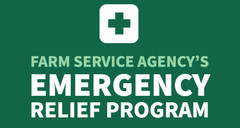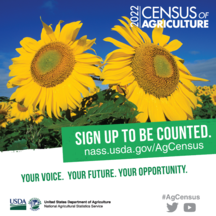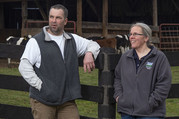
June is upon us and with it I'm sure everyone is busy in the fields planting, mowing, fixing fence and more. Here at FSA we are also approaching our busiest time of year, acreage reporting. If you're finished planting, give your local office a call and make an appointment to get your crops reported, by July 15th.
June is also National Dairy Month! As a former dairy farmer myself, I know the hard work and dedication of our New York dairy farmers. Dairy is the leading agricultural commodity here in New York and there are so many tasty ways to celebrate Nature's Most Perfect Food. My favorite way is with a bowl, or two, of ice cream!
This month I'm also excited to announce the New York Farm Service Agency State Committee has been appointed by Secretary Vilsack. They are:
- Committee Chair Norman Greig, Red Hook, Dutchess County
- Greig operates Greig Farm - a third-generation farm in the Hudson Valley on over 300 acres. The farm specializes in pick your own fruits and vegetables with over 100,000 visitors annually. He has over 15 years of prior service on the NY State Committee and returns now as the State Committee Chair.
- Larry Eckhardt – Stephentown, Rensselaer County
- Eckhardt and his family operate Kinderhook Creek Farm, a diversified fresh market vegetable, field crop and livestock operation covering 1250 acres. Eckhardt served 4 years on the previous State Committee.
- Jill Gould – Pavilion, Wyoming County
- Gould and her husband are working on the family organic dairy farm, Har-Go Farms. In addition, Gould started Butter Meat Co., purchasing and processing dairy animals as an alternative and sustainable source of beef.
- Julian Mangano – Castorland, Lewis County
- Mangano began farming six years ago, establishing Della Terra Farm, a small organic farm focused on sustainability and resiliency in our food system. The farm produces vegetables and cut flowers.
- Michael McMahon – Homer, Cortland County
- McMahon operates EZ Ares Farm LLC, a sixth-generation farm with 900 head of dairy cattle, operating 2700 acres of land. The farm has received wide recognition and won numerous awards for animal welfare and environmental stewardship.
Our first committee meeting is planned for later this month and I'm delighted to begin working with these five impressive individuals. We are fortunate to have them on our State Committee, providing oversight and guidance to the Farm Service Agency in NY. Together they represent the tremendous diversity of the agricultural industry in the Empire State.
Sincerely,
Jim Barber
|

FSA recently began mailing 303,000 pre-filled applications for the Emergency Relief Program (ERP), a new program designed to help agricultural producers impacted by wildfires, droughts, hurricanes, winter storms, and other qualifying natural disasters experienced during calendar years 2020 and 2021.
The past few years have been tough to say the least. As producers have dealt with the continued impacts of the COVID-19 pandemic, they have also struggled to recover from more frequent, more intense natural disasters. I am grateful that Congress passed, and President Biden signed into law the Extending Government Funding and Delivering Emergency Assistance Act (P.L. 117-43), which includes $10 billion in critical emergency relief.
After extensive stakeholder outreach, including with producers and groups that have not always been included in USDA programs, our team began work developing a responsive, easier-to-access program that could be rolled out in phases. We’re now rolling out the first phase of ERP, which uses existing Federal Crop Insurance or Noninsured Crop Disaster Assistance Program (NAP) data as the basis for calculating initial payments.
By leveraging existing data, we will be able to deliver approximately $6 billion in assistance on a faster timeline; at the same time, my team and I are committed to ensuring that producers who do not have existing data on file with USDA are captured in the second phase of ERP, which will be explicitly focused on filling gaps in previously implemented emergency assistance.
To apply for ERP Phase 1, here’s what you need to do:
- Check Your Mailbox
The form being mailed to you includes eligibility requirements, outlines the application process, and provides estimated ERP payment calculations. Producers will receive a separate application form for each program year in which an eligible loss occurred. Receipt of a pre-filled application is not confirmation that a producer is eligible to receive an ERP phase one payment. This application takes about 0.176 hours (that’s less than 15 minutes) for producers to complete, compared to the former Wildfire and Hurricane Indemnity Program – Plus application which took several hours for producers to complete and even longer for FSA staff.
The deadline to return completed ERP applications to FSA is Friday, July 22, 2022. If you have NAP coverage, you will receive pre-filled ERP applications later this summer. Details on ERP Phase 2 will be forthcoming as well.
- Check Your Eligibility
ERP covers losses to crops, trees, bushes, and vines due to a qualifying natural disaster event in calendar years 2020 and 2021. Eligible crops include all crops for which crop insurance or NAP coverage was available, except for crops intended for grazing. Qualifying natural disaster events include wildfires, hurricanes, floods, derechos, excessive heat, winter storms, freeze (including a polar vortex), smoke exposure, excessive moisture, qualifying drought*, and related conditions.
*Lists of 2020 and 2021 drought counties eligible for ERP are available online.
- Check Required Forms on File with FSA
Producers must have the following forms on file with FSA:
- Form AD-2047, Customer Data Worksheet.
- Form CCC-902, Farm Operating Plan for an individual or legal entity.
- Form CCC-901, Member Information for Legal Entities(if applicable).
- Form FSA-510, Request for an Exception to the $125,000 Payment Limitation for Certain Programs(if applicable).
- A highly erodible land conservation (sometimes referred to as HELC) and wetland conservation certification (Form AD-1026 Highly Erodible Land Conservation (HELC) and Wetland Conservation (WC) Certification) for the ERP producer and applicable affiliates.
If you have previously participated in FSA programs, you will likely have these required forms on file. However, if you’re uncertain or want to confirm the status of your forms, contact your local FSA county office.
- Check Historically Underserved Status with FSA, If Applicable
The ERP payment percentage for historically underserved producers, including beginning, limited resource, socially disadvantaged, and veteran farmers, and ranchers will be increased by 15% of the calculated ERP payment.
To qualify for the higher payment percentage, eligible producers must have the following form on file with FSA:
- Form CCC-860, Socially Disadvantaged, Limited Resource, Beginning and Veteran Farmer or Rancher Certification.
- Check Your Future Insurance Coverage
All producers who receive ERP phase one payments are statutorily required to purchase crop insurance, or NAP coverage where crop insurance is not available, for the next two available crop years, as determined by the Secretary.
Coverage requirements will be determined from the date a producer receives an ERP payment and may vary depending on the timing and availability of crop insurance or NAP for a producer’s particular crops. The final crop year to purchase crop insurance or NAP coverage to meet the second year of coverage for this requirement is the 2026 crop year.
- Check Your bank
Once the completed ERP application for payment is submitted to and signed by FSA, producers who have direct deposit should look for payment within three business days.
More Information
We have additional resources, including:
In addition to ERP, FSA is also implementing the first phase of the new Emergency Livestock Relief Program. At this time, FSA has made more than $588 million in payments to impacted livestock producers.
Bottom line, we take your feedback seriously, and we wanted to deliver this relief as soon as possible. We learned from previous relief programs, and we’re excited to be getting this to you as swiftly as we can.
|

Sign up and be counted in the 2022 Ag Census! Agriculture producers who did not receive the 2017 Census of Agriculture and do not receive other USDA surveys or censuses have until June 30 to sign up to receive the 2022 Census of Agriculture at nass.usda.gov/AgCensus. This once-every-five-years data collection begins this November.
The Ag Census includes every American operation – large or small, urban or rural – from which $1,000 or more of agricultural products are produced and sold, or would normally be produced and sold, in the ag census year. This can include hobby farms with livestock, such as chickens or horses, or crops growing in the backyard or on a rooftop. The data inform policy and program decisions that directly impact producers, their operations, industries, and communities. A complete count, with every producer getting and taking the opportunity to be represented in these data, is vital.
On the NASS Ag Census webpage, producers can also access frequently asked questions, explore past and current Ag Census data, access tools to help spread the word about the upcoming Ag Census, learn about Ag Census special studies, and more.
|

Agricultural producers who have not yet completed their crop acreage reports after spring planting should make an appointment with their local Farm Service Agency (FSA) before the applicable deadline.
An acreage report documents a crop grown on a farm or ranch and its intended uses. Filing an accurate and timely acreage report for all crops and land uses, including failed acreage and prevented planted acreage, can prevent the loss of benefits.
How to File a Report
The following acreage reporting dates are applicable for New York:
June 15, 2022 - Onions
July 15, 2022 - Corn, Soybeans, Spring Planted Small Grains and most other crops including CRP and cover crops
August 15, 2022 - Cabbage & Beans
Service Center staff continue to work with agricultural producers via phone, email, and other digital tools. Because of the pandemic, some USDA Service Centers are open to limited visitors. Contact your FSA office to set up an in-person or phone appointment.
To file a crop acreage report, you will need to provide:
- Crop and crop type or variety.
- Intended use of the crop.
- Number of acres of the crop.
- Map with approximate boundaries for the crop.
- Planting date(s).
- Planting pattern, when applicable.
- Producer shares.
- Irrigation practice(s).
- Acreage prevented from planting, when applicable.
- Other information as required.
Acreage Reporting Details
The following exceptions apply to acreage reporting dates:
- If the crop has not been planted by the acreage reporting date, then the acreage must be reported no later than 15 calendar days after planting is completed.
- If a producer acquires additional acreage after the acreage reporting date, then the acreage must be reported no later than 30 calendar days after purchase or acquiring the lease. Appropriate documentation must be provided to the county office.
Producers should also report crop acreage they intended to plant, but due to natural disaster, were unable to plant. Prevented planting acreage must be reported on form CCC-576, Notice of Loss, no later than 15 calendar days after the final planting date as established by FSA and USDA’s Risk Management Agency.
Noninsured Crop Disaster Assistance Program (NAP) policy holders should note that the acreage reporting date for NAP-covered crops is the earlier of the dates listed above or 15 calendar days before grazing or harvesting of the crop begins.
More Information
For questions, please contact your local FSA office.
|

The Farm Service Agency’s (FSA) Farm Storage Facility Loan (FSFL) program provides low-interest financing to help you build or upgrade storage facilities and to purchase portable (new or used) structures, equipment and storage and handling trucks.
Eligible commodities include corn, grain sorghum, rice, soybeans, oats, peanuts, wheat, barley, minor oilseeds harvested as whole grain, pulse crops (lentils, chickpeas and dry peas), hay, honey, renewable biomass, fruits, nuts and vegetables for cold storage facilities, floriculture, hops, maple sap and syrup, rye, milk, cheese, butter, yogurt, meat and poultry (unprocessed), eggs, and aquaculture (excluding systems that maintain live animals through uptake and discharge of water). Qualified facilities include grain bins, hay barns and cold storage facilities for eligible commodities.
Loans up to $50,000 can be secured by a promissory note/security agreement, loans between $50,000 and $100,000 may require additional security, and loans exceeding $100,000 require additional security.
You do not need to demonstrate the lack of commercial credit availability to apply. The loans are designed to assist a diverse range of farming operations, including small and mid-sized businesses, new farmers, operations supplying local food and farmers markets, non-traditional farm products, and underserved producers.
For more information, contact your local USDA Service Center or visit fsa.usda.gov/pricesupport.
|
The U.S. Department of Agriculture (USDA) will allow Conservation Reserve Program (CRP) participants who are in the final year of their CRP contract to request voluntary termination of their CRP contract following the end of the primary nesting season for fiscal year 2022. Participants approved for this one-time, voluntary termination will not have to repay rental payments, a flexibility implemented this year to help mitigate the global food supply challenges caused by the Russian invasion of Ukraine and other factors. Today, USDA also announced additional flexibilities for the Environmental Quality Incentives Program (EQIP) and Conservation Stewardship Program (CSP).
FSA is mailing letters to producers with expiring acres that detail this flexibility and share other options, such as re-enrolling sensitive acres in the CRP Continuous signup and considering growing organic crops. Producers will be asked to make the request for voluntary termination in writing through their local USDA Service Center.
If approved for voluntary termination, preparations can occur after the conclusion of the primary nesting season. Producers will then be able to hay, graze, begin land preparation activities and plant a fall-seeded crop before October 1, 2022. For land in colder climates, this flexibility may allow for better establishment of a winter wheat crop or better prepare the land for spring planting.
Organic Considerations
Since CRP land typically does not have a recent history of pesticide or herbicide application, USDA is encouraging producers to consider organic production. USDA’s Natural Resources Conservation Service (NRCS) provides technical and financial assistance to help producers plan and implement conservation practices, including those that work well for organic operations, such as pest management and mulching. Meanwhile, FSA offers cost-share for certification costs and other fees.
Other CRP Options
Participants can also choose to enroll all or part of their expiring acres into the Continuous CRP signup for 2022. Important conservation benefits may still be achieved by re-enrolling sensitive acres such as buffers or wetlands. Expiring water quality practices such as filter strips, grass waterways, and riparian buffers may be eligible to be reenrolled under the Clean Lakes, Estuaries, and Rivers (CLEAR) and CLEAR 30 options under CRP. Additionally, expiring continuous CRP practices such as shelterbelts, field windbreaks, and other buffer practices may also be re-enrolled to provide benefits for organic farming operations.
If producers are not planning to farm the land from their expiring CRP contract, the Transition Incentives Program (TIP) may also provide them two additional annual rental payments after their contract expires on the condition that they sell or rent their land to a beginning or veteran farmer or rancher or a member of a socially disadvantaged group.
Producers interested in the Continuous CRP signup, CLEAR 30, or TIP should contact FSA by Aug. 5, 2022.
NRCS Conservation Programs
USDA also encourages producers to consider NRCS conservation programs, which help producers integrate conservation on croplands, grazing lands and other agricultural landscapes. EQIP and CSP can help producers plant cover crops, manage nutrients and improve irrigation and grazing systems. Additionally, the Agricultural Conservation Easement Program (ACEP), or state or private easement programs, may be such an option. In many cases, a combination of approaches can be taken on the same parcel. For example, riparian areas or other sensitive parts of a parcel may be enrolled in continuous CRP and the remaining land that is returned to farming can participate in CSP or EQIP and may be eligible to receive additional ranking points.
Other Flexibilities to Support Conservation
Additionally, NRCS is also offering a new flexibility for EQIP and CSP participants who have cover cropping including in their existing contracts. NRCS will allow participants to either modify their plans to plant a cover crop (and instead shift to a conservation crop rotation) or delay their cover crop plans a year, without needing to terminate the existing contract. This will allow for flexibility to respond to market signals while still ensuring the conservation benefits through NRCS financial and technical assistance for participating producers.
More Information
Producers and landowners can learn more about these options by contacting FSA and NRCS at their local USDA Service Center.

In this Ask the Expert, Jack Carlile, Farm Loan Manager for the USDA Farm Service Agency (FSA), answers questions about farm operating loans and when producers should apply in order to secure funds for the current crop year.
As the Farm Loan Manager for the Cherokee County Service Center, Jack is responsible for managing the loan making and loan servicing activities for five counties in northeast Oklahoma. His office provides services for over 650 farm loan customers. Jack was raised on a cross bred cow/calf operation that his grandparents started. Over the years, each generation has added to the operation by purchasing additional pasture. The operation also grows and bales their own hay. Jack’s agriculture background and degree in agriculture economics from Oklahoma State University help him better understand the financing needs of his producers.
Who can apply for FSA Farm Loans?
Anyone can apply for FSA’s loan programs. Applications will be considered on basic eligibility requirements. To apply for a loan, you must meet the following general eligibility requirements including:
- Be a U.S. citizen or qualified alien.
- Operator of a family farm or ranch.
- Have a satisfactory credit history.
- Unable to obtain credit elsewhere at reasonable rates and terms to meet actual needs.
- Not be delinquent on any federal debts.
What can I purchase with operating loans?
Farm Operating Loans are traditionally used for purchasing capital items such as farm machinery, equipment, or livestock. Loan funds can also be used to help pay typical operating expenses for farming and ranching operations. For example, a rancher may use an operating loan to purchase forage for his cattle to feed them through the winter or a row crop producer may use an operating loan for paying for inputs like seed or fertilizer.
What is the maximum loan amount and terms?
The maximum loan amount for a Direct Farm Operating Loan is $400,000. Direct loans are made and serviced by FSA.
Producers can also apply for Guaranteed Operating Loans that are made by your commercial lender, and guaranteed against loss by FSA. The maximum loan amount for a Guaranteed Farm Operating Loan is $1,825,000. Loan terms for operating loans range from one to seven years.
How do I apply?
If you’re interested in applying for a farm loan, you can pick up an application by visiting your local FSA office. Visit farmers.gov to find the USDA Service Center nearest you.
When applying for a loan, you will need a business plan, which must include:
- Your mission, vision, and goals for your farm or ranch.
- Your current assets and liabilities.
- Marketing Plan (what your operation will produce and where you will market and sell your products.)
- Whether the amount of income your operation generates will be enough to pay your business and family living expenses.
When should I apply for an operating loan?
I would recommend beginning the application process a few months in advance of needing the funds to allow time for the request to be processed, and for any necessary security checks and searches to be completed. That allows time for the funds to be available for your use when most needed.
Where can I find more information?
To learn more about FSA loans visit farmers.gov/loans or fsa.usda.gov/farmloans. Fact sheets and application packages are also available at your USDA Service Center. To learn more about other types of FSA loans or to find the right loan for your operation, use the Farm Loan Discovery Tool by visiting farmers.gov/loans/farm-loan-discovery-tool.
|

FSA is cleaning up our producer record database and needs your help. Please report any changes of address, zip code, phone number, email address or an incorrect name or business name on file to our office. You should also report changes in your farm operation, like the addition of a farm by lease or purchase. You should also report any changes to your operation in which you reorganize to form a Trust, LLC or other legal entity.
FSA and NRCS program participants are required to promptly report changes in their farming operation to the County Committee in writing and to update their Farm Operating Plan on form CCC-902.
To update your records, contact your local USDA Service Center.
|
Farm Service Agency (FSA) is committed to providing our farm loan borrowers the tools necessary to be successful. FSA staff will provide guidance and counsel from the loan application process through the borrower’s graduation to commercial credit. While it is FSA’s commitment to advise borrowers as they identify goals and evaluate progress, it is crucial for borrowers to communicate with their farm loan staff when changes occur. It is the borrower’s responsibility to alert FSA to any of the following:
- Any proposed or significant changes in the farming operation
- Any significant changes to family income or expenses
- The development of problem situations
- Any losses or proposed significant changes in security
If a farm loan borrower can’t make payments to suppliers, other creditors, or FSA on time, contact your farm loan staff immediately to discuss loan servicing options.
For more information on FSA farm loan programs, contact your local USDA Service Center or visit fsa.usda.gov.
|